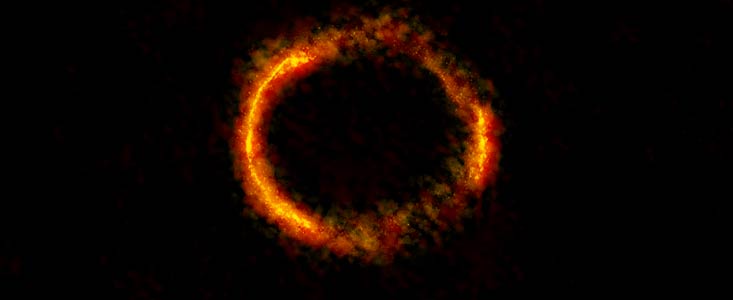Tiedote
ALMA at Full Stretch Yields Spectacular Images
7. huhtikuuta 2015
Images of unequalled sharpness that show the almost perfect gravitational Einstein ring of a distant galaxy and the surface of the asteroid Juno have recently been captured by the Atacama Large Millimeter/submillimeter Array (ALMA). These stunning pictures were taken at the end of 2014 as part of ALMA’s Long Baseline Campaign, which has successfully tested and verified the telescope’s ability to see the finest details. This is achieved when the antennas are at their greatest separation: up to 15 kilometres apart.
Five targets were selected for study during the ALMA Long Baseline Campaign. They included the protoplanetary disc HL Tauri, the gravitationally lensed galaxy SDP.81, asteroid Juno, the star Mira, and the quasar 3C138. The Astrophysical Journal Letters has published four scientific papers written by representatives of the entire international team of the ALMA Partnership, detailing these observations.
SDP.81 is an active star-forming galaxy nearly seen at a time when the Universe was only 15 percent of its current age. It is being lensed by a massive foreground galaxy that is a comparatively close four billion light-years away. The gravitational lensing has created an almost perfect Einstein ring. ALMA’s resolution with long baselines on this target exceeds that of all other telescopes that have observed it, including the NASA/ESA Hubble Space Telescope, and reveals much fine structure in the ring that has never been seen before.
The second target was much closer to home. A series of images made with ALMA provided an unprecedented view of the surface of Juno, one of the largest members of the Solar System's main asteroid belt. Linked together into a brief animation, these high-resolution images show the rotation of the asteroid as it shines in millimetre-wavelength light.
The complete sequence of ALMA observations was conducted over the course of four hours, when Juno was approximately 295 million kilometres from Earth. The resolution of the new ALMA observations is a vast improvement over earlier observations made at similar wavelengths and is enough to clearly resolve the irregular shape of the asteroid and potentially tease out prominent surface features.
The five objects were chosen to show the scientific potential of ALMA, the world’s largest ground-based observatory, in its most extended configuration.
More Information
The Atacama Large Millimeter/submillimeter Array (ALMA), an international astronomy facility, is a partnership of ESO, the US National Science Foundation (NSF) and the National Institutes of Natural Sciences (NINS) of Japan in cooperation with the Republic of Chile. ALMA is funded by ESO on behalf of its Member States, by NSF in cooperation with the National Research Council of Canada (NRC) and the National Science Council of Taiwan (NSC) and by NINS in cooperation with the Academia Sinica (AS) in Taiwan and the Korea Astronomy and Space Science Institute (KASI). ALMA construction and operations are led by ESO on behalf of its Member States; by the National Radio Astronomy Observatory (NRAO), managed by Associated Universities, Inc. (AUI), on behalf of North America; and by the National Astronomical Observatory of Japan (NAOJ) on behalf of East Asia. The Joint ALMA Observatory (JAO) provides the unified leadership and management of the construction, commissioning and operation of ALMA.
Linkit
- Photos of ALMA
- Preprint about ALMA observations of SDP.81
- Preprint about ALMA observations of Juno
- Preprint about ALMA observations of HL Tauri
Yhteystiedot
Richard Hook
ESO, Public Information Officer
Garching bei München, Germany
Tel: +49 89 3200 6655
Cell: +49 151 1537 3591
Email: rhook@eso.org
Tiedotteesta
| Tunnistus: | ann15028 |


